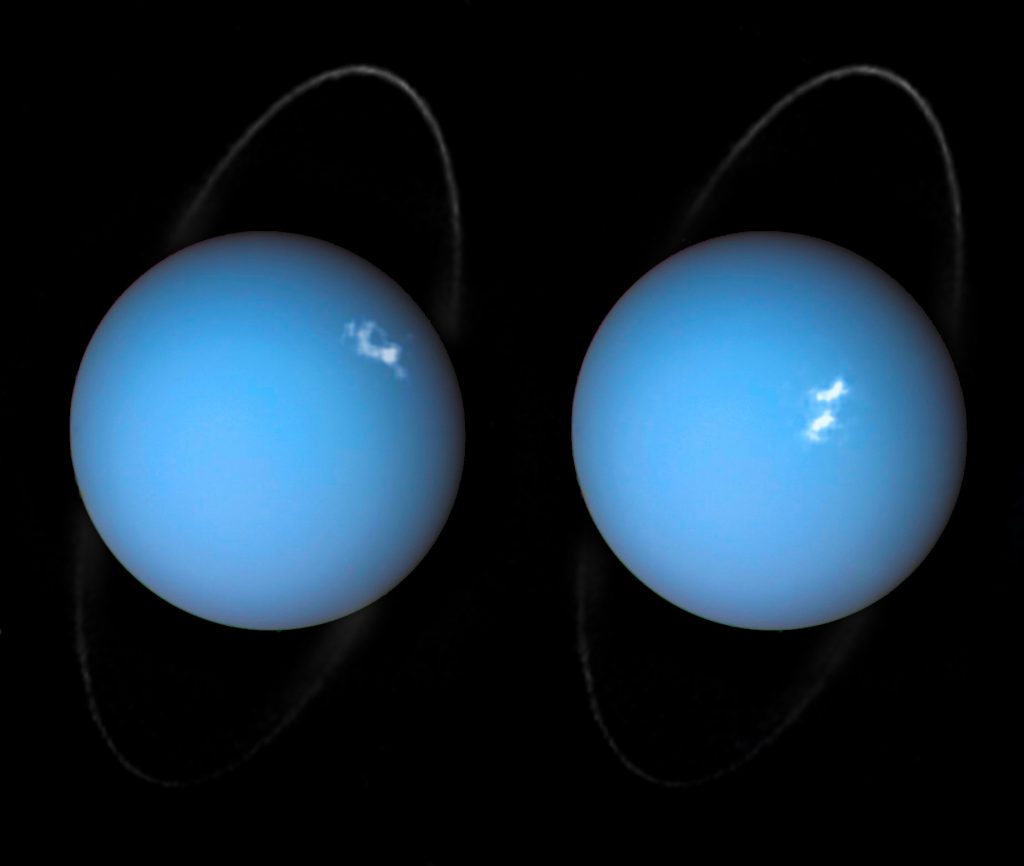3 April 2017
Untangling Uranus’s topsy-turvy magnetosphere
Posted by Lauren Lipuma
By Larry O’Hanlon
New observations of Uranus being buffeted by shock waves from the sun have revealed auroral activity and fresh clues to the workings of the seventh planet’s unusual magnetosphere, the region of space dominated by its magnetic field.
Mapping out the magnetospheres of planets like Earth, Jupiter and Saturn is comparatively straight forward, because bright aurorae light up in neat bullseye rings around the magnetic poles. Those magnetic poles also generally align – within 20 degrees – with the planets’ spin, or rotation axes.
Uranus is the nonconformist of the solar system, however. Not only are its aurorae spot-like bursts instead of informative rings, but Uranus’s magnetic poles are about 60 degrees off from its spin axis. That spin is also unlike other planets. Most planets spin like tops on a plate as they orbit the sun. But Uranus rolls around its orbit sideways, like a ball on a track. That means on days nearing Uranus’s equinoxes, one magnetic pole can be aimed almost straight into the solar wind and then almost directly away a half day later.
“In 2014, we obtained new observations from director’s time on the Hubble Space Telescope to sample the arrival of powerful interplanetary shocks – the most powerful ever sampled at Uranus,” said Laurent Lamy, an astronomer at the Observatory of Paris and lead author on a paper reporting the findings in the Journal of Geophysical Research – Space Physics, a journal of the American Geophysical Union.

This is a composite image of Uranus by Voyager 2 and two different observations made by Hubble — one for the ring and one for the aurorae (bright white spots). These images, taken by Hubble, show the first direct evidence that Uranus’s aurorae rotate with the planet. They also re-discovered Uranus’ long-lost magnetic poles, which were lost shortly after their discovery by Voyager 2 in 1986.
Credit: ESA/Hubble and NASA/Laurent Lamy.
The team of scientists from France, the U.S., U.K. and Japan used computer models to forecast when blasts of magnetized solar wind would hit Uranus and trigger the auroral lights in 2014. They then used the Hubble Space Telescope to detect the aurora in far-ultraviolet light.
The team succeeded in detecting four new aurora signals by pairs of successive image: two that were relatively weak and two that were the brightest ever seen with Hubble. In both cases, the auroral signatures were seen to rotate with the planet. These new aurorae were also more elongated that earlier observations. That allowed the researchers to fit them with models that revealed the longitude of both of Uranus’s magnetic poles.
The longitudes of the magnetic poles were first measured in 1986 by the only spacecraft to have ever visited the planet: Voyager 2. But the longitude was soon lost owing to the low-accuracy measurement of Uranus’s rotation period. Now, with the newly determined longitudes and Voyager 2’s original measurements, researchers hope to be able to reconstruct a longitude system for Uranus’s magnetic poles for the last 30 years and determine the rotation period at high resolution. That, among other things, helps other researchers who are working to develop models that test hypotheses about how the oddball planet formed.
The new observations have also raised new questions about the interplay of the solar wind, the planet’s oddly orientated magnetosphere and Uranus’s rotation, which they hope to answer with more modeling and, additional observations.
“The occurrence of auroral bursts strikingly close to the predicted solar wind shocks suggests that, if the planetary rotation plays a role in the occurrence of aurora, so does the solar wind as well,” said Lamy. “This is the most dynamic geometry of a planetary magnetosphere known so far.”
— Larry O’Hanlon is a science writer and manager of the AGU blogosphere.










 GeoSpace is a blog on Earth and space science, managed by AGU’s Public Information staff. The blog features posts by AGU writers and guest contributors on all sorts of relevant science topics, but with a focus on new research and geo and space sciences-related stories that are currently in the news.
GeoSpace is a blog on Earth and space science, managed by AGU’s Public Information staff. The blog features posts by AGU writers and guest contributors on all sorts of relevant science topics, but with a focus on new research and geo and space sciences-related stories that are currently in the news.